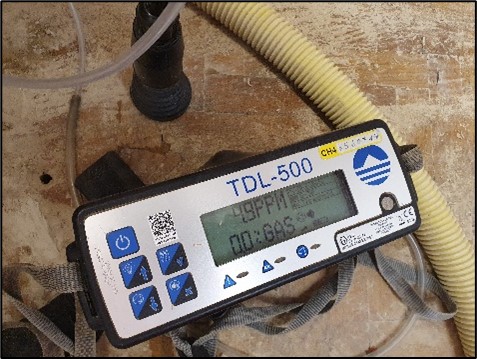- Continuous ground gas monitoring
- Ground gas sampling
- Radiocarbon dating of methane
- GGS DataPack Plus Report
This site required a period of continuous ground gas monitoring to support a landfill permit surrender application. It comprised of an infilled area of land, with an active landfill permit. Historically, the site was understood to have accepted inert waste under permit and infilling activities ceased a substantial time ago. The Client was in the process of supporting the landowner with the landfill permit surrender process.
Ahead of a potential permit surrender application, historical periodic monitoring records collected over a decade had been reviewed by The Client. Elevated concentrations of methane and carbon dioxide had been largely sustained over time. For a landfill of this type and age, gas ratios would have been expected to change through time as the gas generation potential of the waste reduced.
The monitoring evidence suggested that the measured gas concentrations, particularly the high methane concentrations, were associated with natural deposits at depth(alluvium/peat), and that the data did not evidence continued significant gas generation within the waste/made ground. However, robust evidence was required to fully determine the gas nature/behaviour and provenance.
GGS mobilised to site to deploy Gas Sentinel® continuous ground gas monitoring equipment within five newly constructed wells. Instruments were configured to record standard ground gases (methane, carbon dioxide, oxygen, carbon monoxide and hydrogen sulphide), gas flow, atmospheric pressure and atmospheric temperature, at hourly intervals for the extended monitoring period.
Monitoring locations targeted wells exclusively screening the natural deposits at depth and the shallow waste deposits and wells that were considered to be outside the made ground and presented potential migration pathway locations. Key lines of enquiry were to observe gas behaviour and variability under falling atmospheric pressure, and to identify whether high gas concentrations were associated with positive flow rates.
To provide additional lines of evidence, GGS also obtained gas samples. Samples were dispatched for analysis of a routine ground gas suite to confirm gas concentrations and presence of trace gases. Furthermore, radiocarbon dating of methane was requested to provide further insight to gas provenance.
Due to the analysis type, wells had to be sampled when methane concentrations were high to minimise the gas sample volume required. GGS ensured samples were taken during a preferable window by following the atmospheric pressure trend remotely and reviewing the continuous monitoring data. Samples were taken from the continuous monitoring locations via a by-pass valve to ensure representative samples were obtained, without the introduction of ambient air to the well.
GGS provided the client with a GGS DataPack Plus Report, which included monitoring details, periodic monitoring data, validated time series data, atmospheric pressure analysis, concentrations duration analysis, laboratory results and an interpretative technical commentary of the time series data to aid the client in their assessment and permit surrender application.
The report provided robust evidence that measured gas concentrations were largely associated with the natural deposits and not the landfill deposits. This in turn provided evidence that significant active gas generation was not occurring within the made ground deposits. The continuous monitoring programme provided the client with a quality data set within relatively short timescales to support the permit surrender process.




